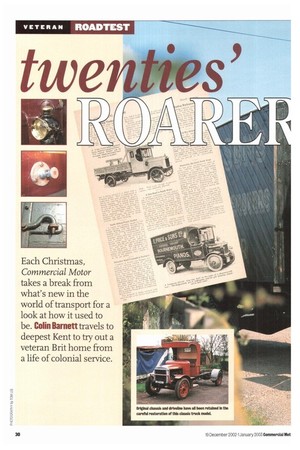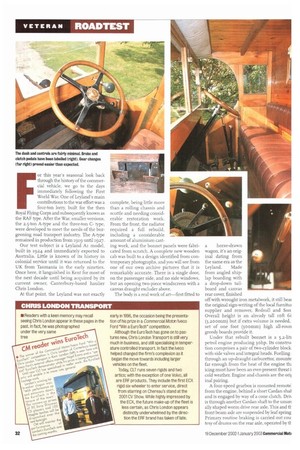twenties
Page 30

Page 32

Page 33

If you've noticed an error in this article please click here to report it so we can fix it.
Each Christmas, Commercial Motor
takes a break from urn,. nk, v.!
what's new in the
world of transport for a look at how it used to be. Colin Barnett travels to deepest Kent to try out a veteran Brit home from a life of colonial service. For this year's seasonal look back through the history of the commercial vehicle, we go to the days immediately following the First World War. One of Leyland's main contributions to the war effort was a four-ton lorry, built for the then Royal Flying Corps and subsequently known as the RAF type. After the War, smaller versions. the 2.5-ton A-type and the three-ton Ctype, were developed to meet the needs of the burgeoning road transport industry. The A-type remained in production from 1919 until 1927.
Our test subject is a Leyland At model, built in 1924 and immediately exported to Australia. Little is known of its history in colonial service until it was returned to the UK from Tasmania in the early nineties. Once here, it languished in Kent for most of the next decade until being acquired by its current owner, Canterbury-based haulier Chris London.
At that point, the Leyland was not exactly
complete, being little more than a rolling chassis and scuttle and needing considerable restoration work. From the front, the radiator required a full rebuild, including a considerable amount of aluminium cast
ing work, and the bonnet panels were fabricated from scratch. A complete new wooden cab was built to a design identified from contemporary photographs. and you will see from one of our own archive pictures that it is remarkably accurate. There is a single door, on the passenger side, and no side windows, but an opening two-piece windscreen with a canvas draught excluder above.
The body is a real work of art—first fitted to a horse-drawn wagon, it's an original dating from the same era as the Leyland. Made from angled shiplap boarding with a drop-down tailboard and canvas rear cover, finished off with wrought iron metalwork, it still beat the original sign-writing of the local furnitui supplier and remover, Redsull and Son Overall height is an already tall loft 6i (3,200mm) but if extra volume is needed, set of one foot (300mm) high all-roun greedy boards provide it.
Under that rebuilt bonnet is a 5.2-lin petrol engine producing 3ohp. Its construi tion comprises a pair of two-cylinder block with side valves and integral heads. Fuelling: through an up-draught carburettor. mounte far enough from the heat of the engine th icing must have been an ever-present threat i cold weather. Engine and diassis are the oril inal pairing.
A four-speed gearbox is mounted remote: from the engine, behind a short Cardan shal and is engaged by way of a cone clutch. Dril, is through another Cardan shaft to the unusi ally shaped worm drive rear axle. This and th front beam axle are suspended by leaf spring Primary routine braking is carried out cou tesy of drums on the rear axle, operated by ft and lever, while the foot pedal is intended for mergency use only, acting on a separate ransmission brake. In normal driving, howvet the engine produces sufficient retardaLon to ensure that neither system is greatly roubled, except on significant hill descents.
Although this Leyland was originally fitted rith solid rubber tyres, its original artillery-type /heel hubs and spokes have at some point been ielded to American-style rims to allow the use f new-fangled 36x6 pneumatic tyres. This is lot as great a loss of authenticity as it might ppear, as our archives show that Leylands were sing balloon tyres in early 1924.
the road
f the Leyland suffers from the odd mechanial malady, as a veteran of that age is entitled 3 do, the passengers will be as inconveiienced as the driver, as they have to disnount to let him out of the single entry cab. Ye can vouch for that, as a slightly misaligned uel tap caused us to proceed somewhat errat:ally for the first few hundred yards.
Once under way, though, tucked into the orner of the cosy padded three-seater pew, hings were fine.
The dash and controls are minimal. There s a hand throttle and ignition advance and etard lever on the steering column, the latter rnly needed for starting, which is achieved by and cranking only. As originally built, the ,nly pedals were clutch and brake, thoughtully labelled "C" and "B". although a foot hrottle was added during the rebuild. The par and handbrake levers are mounted to thy Eriver's right.
Forward gears are located in a conventional -I-pattern, but reverse is found by lifting a itch and pushing forward from first gearinconventional but handy during shunting nanoeuvres. On level ground and lightly aden, second gear was fine for starting off. Uthough described generously as a clutch, the levice at the other end of the left-hand pedal hould more accurately be called a switch.
Although operating through a fairly convoated linkage, and being nearly 8o years old, the :earshift is remarkably precise—better than ome available until just a few years ago. Changing up through the gears proved surprisingly easy. although considerable concentration and precision is called for to provide something like the right revs at the right time. We cheated slowing down, though, staying in top until almost at a standstill. According to its regular driver, hill-induced downshifts are best left until the engine is on the verge of stalling.
The Leyland's realistic top speed of aomph was quite enough for its novice driver. Not unexpectedly, the steering was on the heavy side, but by no means impossible. It was surprisingly accurate most of the time, its only downside being an occasional tendency to launch into a serious shimmy when triggered by certain road surface defects.
The only ergonomic problem we found was the restricted space for the right foot to operate the throttle, but once at speed cruise control (all right, hand throttle) could be engaged. At the speeds attained, comfort was hardly an issue, but the seat padding absorbed most bumps. Thanks to the open cab, most engine noise was dissipated and normal conversation was perfectly possible. And there's plenty of fresh air too!
Summary
The period immediately after the First War was nothing less than the beginning of a revolution in the transport industry. The war itself had proved the value of road transport, as well as providing a pool of men trained in the operation of the motor lorry. The years that followed saw the brief period of dominance by rail begin along but irreversible decline that meant transport would never be the same again.
Leyland Motors' products. both the 3,000 plus reconditioned ex-military vehicles and the new generations typified by this test's subject. played a major part in this revolution, Although this Leyland's restoration may upset the sniffiest purist, in cab and body terms anyway, at least it is carried and propelled by a truly original chassis and driveline, which can't always be said.
With only around to of the type existing in the UK, Chris London is to be commended for returning another example of this highly important piece of our heritage to the roads.
CHRIS LONDON TRANSPORT
II Readers with a keen memory may recall seeing Chris London appear in these pages in the past. In fact, he was photographed
under the very same early in 1996, the occasion being the presentation of his prize in a Commercial Mofcr/Iveco Ford 'Win a EuroTech" competition.
Although the EuroTech has gone on to pastures new, Chris London Transport is still very much in business, and still specialising in temperature controlled transport. In fact the lveco helped changed the firm's complexion as it began the move towards including larger vehicles on the fleet.
Today, CLT runs seven rigids and two artics; with the exception of one Volvo, all are ERF products. They include the first ECX rigid six-wheeler to enter service, direct from starring on Chereau's stand at the 2001 CV Show. While highly impressed by the ECX, the future make-up of the fleet is less certain, as Chris London appears distinctly underwhelmed by the direction the ERF brand has taken of late.
































































































































































